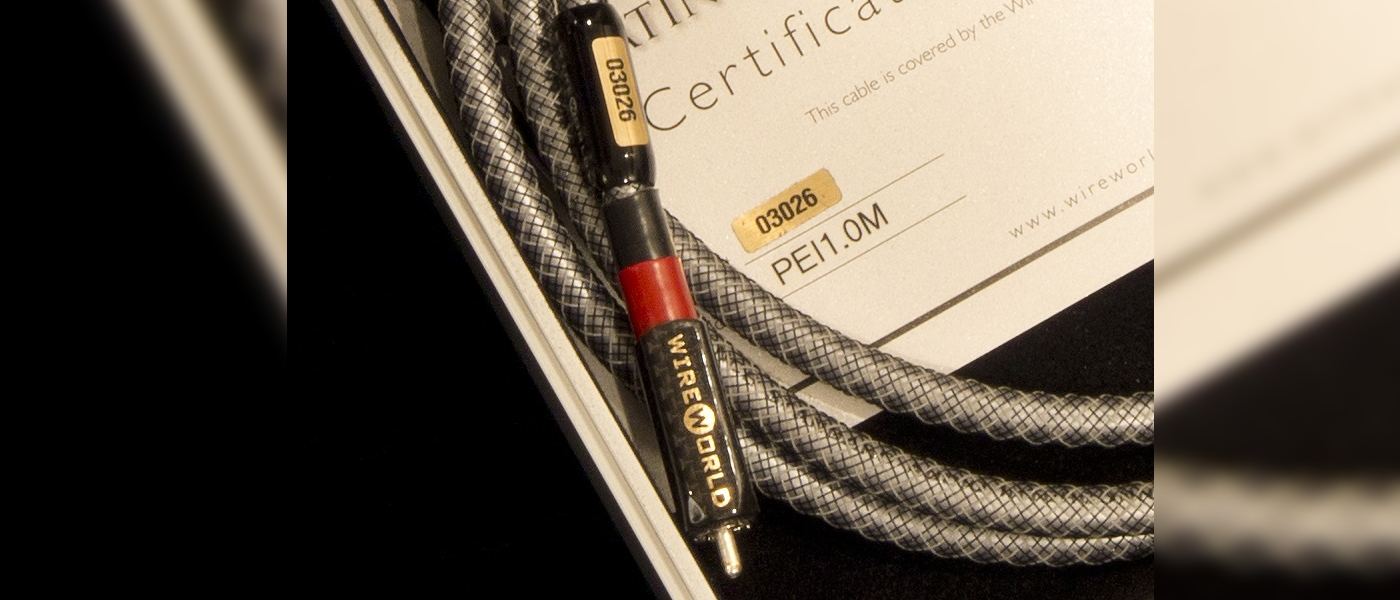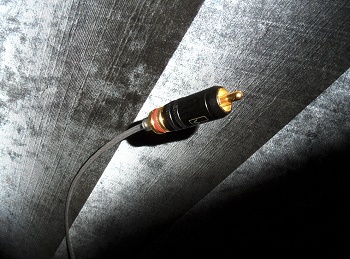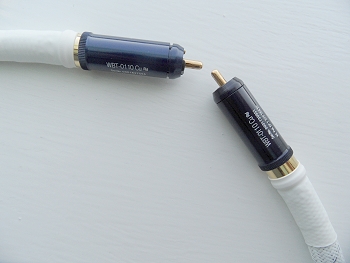
Marc Audio Red Line (Signature) and Black Line (Reference) RCA Interconnects: Introduction and Design
Marc Audio is a new audio cable manufacturer that set up shop in October, 2010. I received a sample of their first product, an RCA interconnect that is their mid-level line of audio cables, called the Red Line (as of June, 2011, they renamed them as the Signature Line), shown in the first photo, above, and we published a review of those cables in November, 2010. Subsequently, I received a sample of their mid-level product, the Black Line (shown in the second photo, above), renamed the Reference Line as of June, 2011. They also offer their White Line, renamed the Premium Line as of June, 2011, which is the least expensive line. (The renaming occurred as a result of confusion due to the color not matching the actual color of the cable.) This review is an updated version of our review of the Red Line that we published in November, 2010.
I thought it might just be more of the same. But, it turned out, Marc Audio cables are different. For one thing, they are totally a USA product. The wires are manufactured in North Prairie, Wisconsin, and the assembly and termination are done in Door County, Wisconsin. The cables are beautifully made, with high quality RCA plugs (gold-plated copper alloy). But, the big surprise is the mid-level priced ($440/meter-pair) cables outperformed my $4,000/pair interconnects. The Black Line interconnect bench tested even better than the Red Line. The configuration of the conductors is proprietary, but for the Red Line, it appears they are using a single conductor in the center, with a very thin spiral ground. The outer covering feels like Teflon, and the shielding looks like silver, which would have to be the case if the covering is Teflon.
Here is a photo of the inside of the Red Line RCA plug, and you can see the very small single hot conductor. It appears to be copper rather than silver plated copper or solid silver.
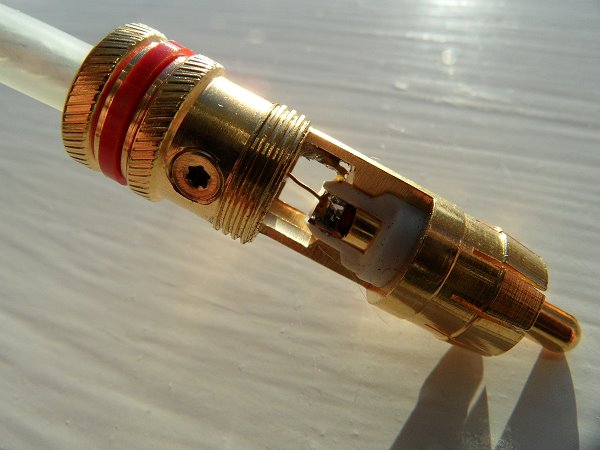
The photo below shows a close-up of the Black Line RCA connector. You can see that the conductor (red arrow) is silver, and in fact, consists of seven 33 gauge fine solid silver conductors wound tightly together. The plug itself is of the latest variety, which has two polymer prongs and a single copper conductive prong for the ground (blue arrow). This configuration is reported to reduce eddy currents.
Silver oxide is highly conductive, while copper oxide has more resistance. Thus, with tightly wound fine silver conductors, such as with the Black Line, the silver oxide that forms between the seven conductors will not impede electrons from moving between the conductors as it would if the seven fine wires were made of copper.
The shielding is provided by the same foil/38AWG mesh system that provides the ground path. The insulation between the hot and ground is a two layer system consisting of a thin layer of Teflon over the silver center conductor, and this is covered with a layer of Polyethylene foam approximately five times thicker than the Teflon, about 3mm total diameter. The ground is a solid silver mesh, covered by AL-PET shielding. The bulk of the cable cross-section area comes from the PVC insulation covering the shield/ground. One of the things I like very much about the Black Line is that it is very flexible, so it is quite capable of turning tight corners.
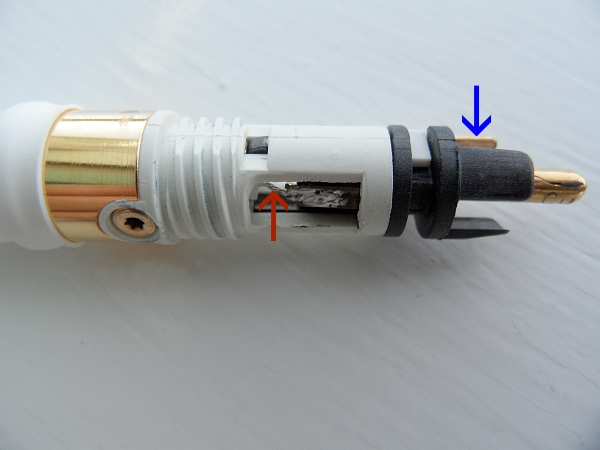
In Use
I tested the Marc Audio Red Line and Black Line interconnects with an OPPO BDP-83 SE/NuForce SACD player, PrimaLuna ProLogue Premium preamplifier, Lamm LL1 preamplifier, McIntosh MC1201 monoblock power amplifiers, and Carver Mark IV ribbon speakers.
My reference cables are about $4,000/pair (1.7 meter length), and I am very familiar with their extremely transparent sound. I am not a cable fanatic per se, but I have accumulated very high quality cables over the years, most of them being high priced, but some are low priced.
So, I listened to a couple of tracks on several SACDs with my reference cables and then replaced them (connections between the SACD player and the preamplifier, and preamplifier to power amplifiers) with the Marc Audio Red Line cables and listened to the same tracks. To my surprise, I heard no difference at all. Now, our readers who feel that cables make no difference will say, “Of course you didn’t hear any difference, because cables are all the same.” That’s fine. In the cable arena, I am a centrist. I do think they make a difference, but I don’t think you have to spend tens of thousands of dollars to get good cables, and that most likely, the connector makes at least as much difference as the cable itself. The RCA plugs on the Red Line interconnects are gold-plated copper alloy. Specifically, the plugs are WBT-0147’s, which work well with small diameter conductors such as is the case with the Red Line interconnects.
On the Bench
The Red Lines that were sent to me for review were 1.7 meters in length, which was the same length as my reference cables. The Black Line interconnects were 1 meter and 5 meters. The test results are shown below, in comparison to my reference cables, which I am calling Cable “X” because I don’t want to single them out since I use several “reference quality” cables.
First, the Marc Audio Red Line interconnects. The overall impedance was 0.4 Ohms and was almost perfectly flat out to 20 kHz. The phase rose to 130 at 20 kHz. Cable “X” had an impedance of 0.7 Ohms out to 3 kHz, then rose to 1.2 Ohms at 20 kHz. The phase was 350 at 20 kHz.
So, what this means is that the reactive impedance of the Marc Audio Red Line cables was constant throughout the audible band, but higher in overall impedance. This can be compensated for by simply turning up the volume control one click. However, while the reference cables had an overall lower impedance, it did not have a flat impedance curve, so the higher impedance at the upper end of the audible band cannot be compensated for by simply turning up the volume. In essence, the reference cables will roll off the high frequencies a bit, regardless of where you set the volume, and there will also be more phase shift than the Red Line interconnects.
In most instances, you probably would not notice any difference, which is what I experienced. However, my components have a flat frequency response. If any of your components roll off at the high end, then the addition of the roll off that you would get with cables that have noticeable increases in impedance in the upper frequency region, would be audible, probably a softening of detail.
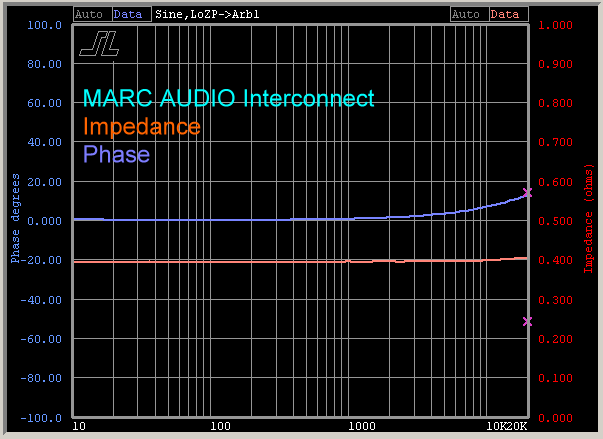
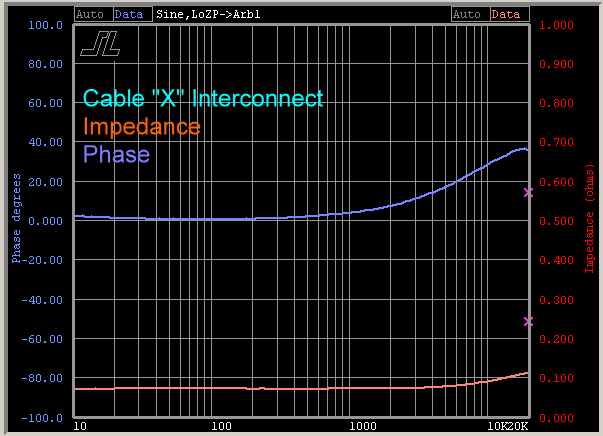
The higher impedance of the Red Lines would be expected if they are using a single small diameter conductor for the hot leg and a thin spiral ground. Every design has its advantages and disadvantages. However, use of the single thin conductor will also limit skin effect (the tendency for high frequencies to travel close to the surface of the conductor, which raises the impedance for these high frequencies). The depth at which the frequencies travel depends on the temperature, and calculation of the depth involves a constant that, for copper, varies between about 2.5 and 2.8 if you want to know the depth in mils (thousandths of an inch) or 66.04 if you want the depth in millimeters. So, the depth for copper at the standardized upper limit of human hearing – 20 kHz – is the constant divided by the square root of the frequency, or 66.04/141.42 = 0.47mm. Therefore, to minimize the skin effect, the conductor should be no larger than 0.47mm. However, this is not an exact cutoff point. It is the point at which 36.8% of the current at 20 kHz is flowing. In other words, having a conductor smaller in diameter than 0.47mm will be even more effective in limiting the skin effect. But, the smaller or thinner the conductor, the more resistance. So, as with all things, it is a compromise, and that is why there are so many different cables with various conductor configurations. In my opinion, the Marc Audio interconnect has a top-notch design.
Below is the Impedance/Phase graphs for the Black Line interconnects. The first one is for a 1 meter interconnect, and the second one is for a 5 meter interconnect. Notice that the impedance in the 1 meter interconnect is about half the impedance value for the Red Line interconnect, taking into account that the Red Line interconnect was nearly twice the length of the Black Line interconnect that I tested. Notice also that the phase for the 1 meter and 5 meter interconnects is almost the same. The Black Line interconnect had 60% less DC resistance (measured at 12 Hz on an LCR meter), 6% less capacitance, and 9% less inductance than the Red Line interconnect.
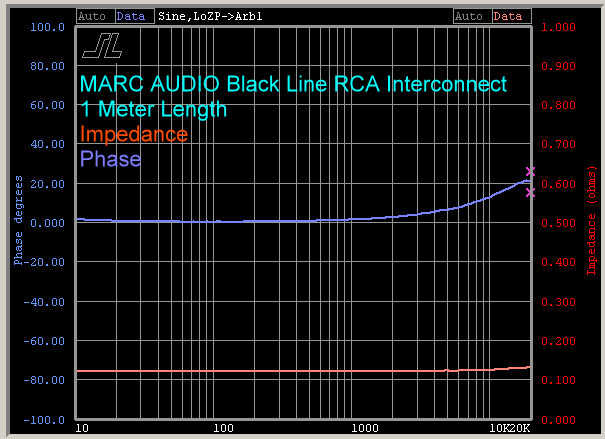
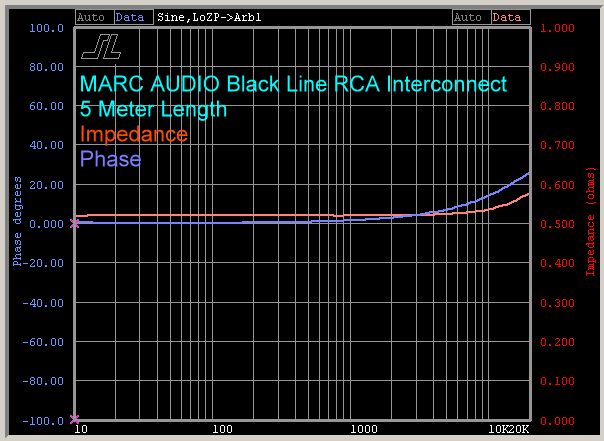
Any differences in the audio quality between the Red Line and Black Line interconnects were too small for me to detect. However, the significantly reduced impedance does cause less change to the signal, and that is the sort of thing that audio aficionados are willing to pay for, even though it is a case of diminishing returns. Squeezing out that last 1-5% of performance is expensive in all audio product categories.
Marc Audio’s products are sold direct-to-consumer at their website.
Marc Audio Red Line Speaker Cables
The Red Line speaker cables are configured as tightly twisted 8 gauge conductors, and are priced at $319 for an 8 foot pair. Termination is a stackable banana plug, although I don’t know of a use for that stacking capability. However, what is definitely useful is that when you turn the rear end of plug where the hole is located, this loosens or tightens the pressure of the banana plug in the speaker binding post. That is a very nice feature that prevents the plug from falling out of the binding post, which banana plugs tend to do when you move the cables around.
I tested the speaker cables using the same setup as I did originally with the Red Line interconnects. I compared them to one of my reference cables (Cable “X”) which is a 15 foot pair (the MSRP for a 2.5 meter pair is $8,500).
Again, as with the interconnects, I could hear no difference between the Marc Audio and Cable “X”. Now, I do have to say that I can hear a difference when I use garden variety lamp cord as speaker cables. The highs tend to roll off. In fact, that is how I got into starting Secrets of Home Theater and High Fidelity. I had been using 12 gauge lamp cord for speaker cables, and I swapped in some inexpensive, but well engineered, audio cable. All of a sudden, the high frequencies were there. I hadn’t known they were missing until I put in those nice audio cables.
Anyway, back to the here and now.
On the Bench
Below is an Impedance/Phase plot for the Marc Audio Red Line Speaker Cables. The Impedance/Phase plot for Cable “X” is shown in the second graph below. We can’t compare the graphs directly, because the lengths were different, but one would assume that the rise in impedance and phase in the high frequencies for Cable “X” would hit the 20 kHz mark at about half way where they did with an 8 foot cable compared to the 15 foot cables. That places the impedance at 0.12 ohms. The Marc Audio cable impedance at 20 kHz was 0.09 ohms, and I consider this difference to be insignificant.
The phase plots for the two cables were very different. Whereas the phase of Cable “X” was near 00 up to about 100 Hz and then rose to 760 at 20 kHz (we could assume it would be about half that with an 8 foot cable), the Marc Audio started out with a high phase and then leveled off to about 800. Although they were different, the variation (taking into account the different length) was about the same. I am not sure what to make of this, other than I did not notice any audible differences between the two cables, and that the sound was excellent.

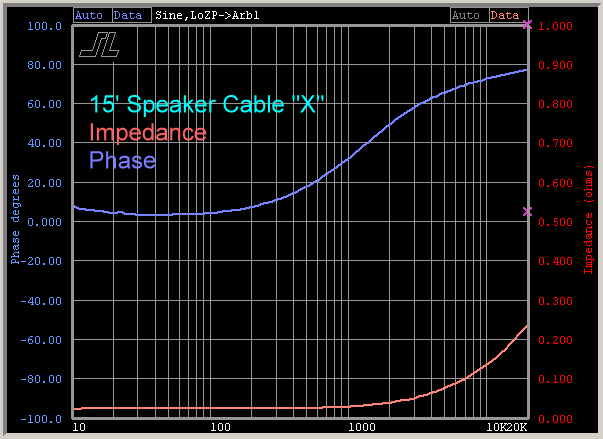
Conclusions
Marc Audio’s products are terrific. Their interconnects and speaker cables are made entirely in the USA and have superb construction quality. They performed as well or better than my much more expensive reference cables, and with the Red Line (Signature) interconnects being priced at a level that might even get a nod from (some) cable nay-sayers, the Marc Audio cables are definitely keepers. We will review their White Line (the least expensive line) soon and add the results to this review.


